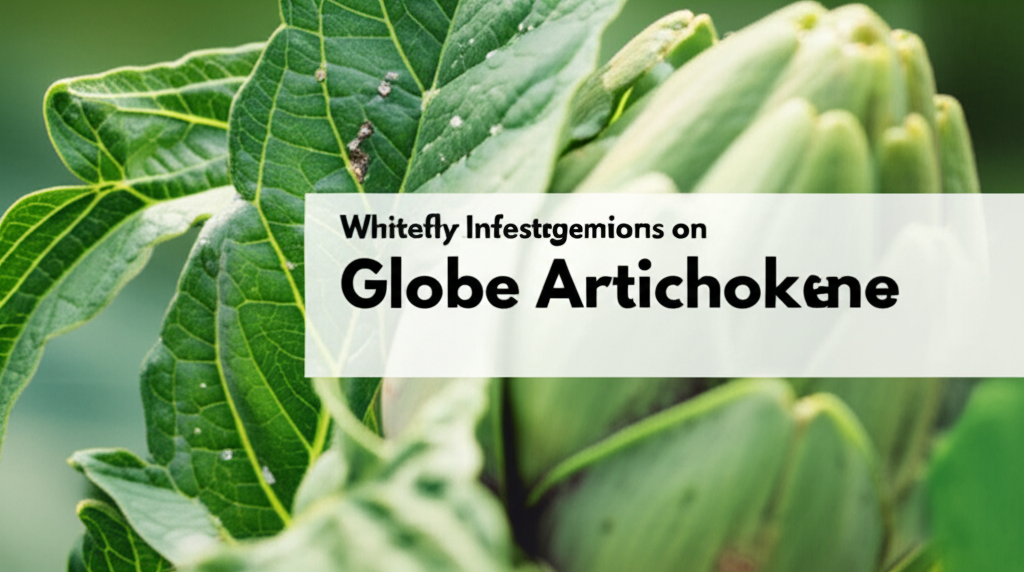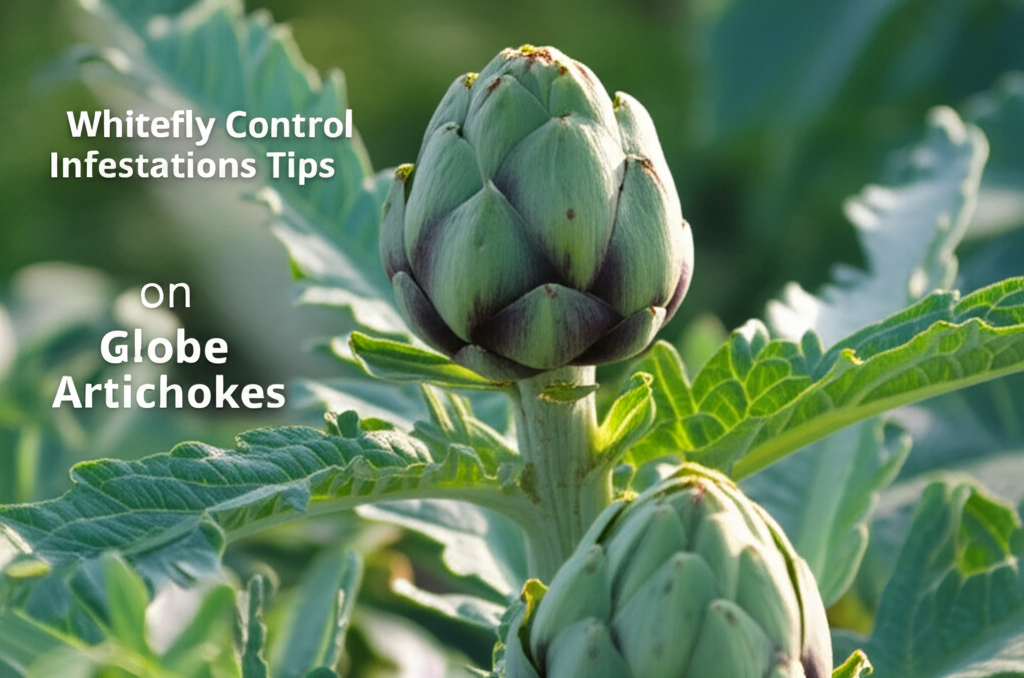Globe artichokes ( Cynara cardunculus var. scolymus ) are striking plants, prized for their edible flower buds. However, their stately presence can be compromised by a persistent and often frustrating pest: the whitefly. These tiny, sap-sucking insects can quickly turn a healthy artichoke patch into a scene of distress, characterized by sticky honeydew, sooty mold, and weakened plants. Effective management of whitefly infestations on globe artichokes requires a multi-faceted approach, integrating cultural practices, biological controls, and, when necessary, targeted chemical interventions. This comprehensive guide will equip you with the knowledge to identify, prevent, and control whiteflies, ensuring your artichoke harvest remains bountiful and healthy.
Understanding the Enemy: The Globe Artichoke Whitefly
Before delving into management strategies, it’s crucial to understand the life cycle and behavior of the most common whitefly species that might target globe artichokes. While several species exist, the greenhouse whitefly (Trialeurodes vaporariorum) and the sweet potato whitefly (Bemisia tabaci) are frequent culprits in vegetable gardens.
Life Cycle of a Whitefly
Whiteflies undergo complete metamorphosis, a cycle that typically includes four distinct stages:
- Egg: Oval-shaped and laid in clusters, usually on the underside of leaves.
- Nymph: After hatching, the nymphs are mobile for a short period before settling on the underside of leaves to feed. They pass through several instars, becoming more flattened and less mobile with each molt. This is often the most damaging stage.
- Pupa: The final nymphal stage, where significant development occurs. The pupal case is often translucent.
- Adult: The winged, moth-like adult emerges from the pupal case. Adults are most active during the day and fly readily when disturbed, often creating a characteristic “white cloud” effect.
Damage Caused by Whiteflies
Whiteflies are primarily sap-suckers. They insert their stylets into the plant tissues to extract sap, which can lead to:
- Stunted Growth: Heavy infestations can weaken plants, leading to reduced vigor and smaller, less developed buds.
- Yellowing Leaves: As they drain nutrients, leaves may turn yellow and eventually drop prematurely.
- Honeydew Production: A sticky, sugary substance excreted by the whiteflies as a byproduct of feeding. This honeydew can coat leaves and stems.
- Sooty Mold: The honeydew provides an ideal substrate for the growth of sooty mold, a black fungus. While the mold itself doesn’t directly harm the plant, it can block sunlight, hindering photosynthesis and making the plant unsightly.
- Virus Transmission: Certain whitefly species are vectors for plant viruses, which can cause significant damage and yield loss.
Preventative Measures: Building a Resilient Artichoke Patch

The most effective way to manage pests is through prevention. Implementing good horticultural practices can significantly reduce the likelihood of a severe whitefly infestation.
Site Selection and Preparation
Choosing the right location and preparing the soil are foundational steps:
- Sunlight: Globe artichokes thrive in full sun, which also helps promote healthy, robust growth, making them more resistant to pests.
- Soil Drainage: Ensure excellent drainage. Waterlogged soil can stress plants and make them more susceptible to various problems, including pest infestations.
- Crop Rotation: While globe artichokes are perennial, rotating where you plant them in your garden year after year (if you have multiple growing areas) can help break pest cycles. If you have a dedicated artichoke patch, focus on other preventative measures.
Healthy Plant Establishment
Starting with strong plants is key:
- Source Healthy Starts: Purchase or propagate plants from reputable sources that are free from pests and diseases.
- Proper Spacing: Give your artichoke plants adequate space to grow. Good air circulation helps prevent the buildup of humidity, which whiteflies favor.
Companion Planting
Certain plants can act as natural deterrents or attract beneficial insects:
- Marigolds: French marigolds are known to repel nematodes and may also deter some flying insects.
- Nasturtiums: These can act as a trap crop, drawing whiteflies away from your artichokes. However, they can also become heavily infested themselves, so monitor them closely and be prepared to manage them.
- Beneficial Insect Attractors: Planting herbs like dill, fennel, and cilantro can attract natural predators of whiteflies.
Regular Monitoring
Vigilance is your best defense:
- Frequent Inspection: Regularly inspect the undersides of artichoke leaves for the presence of whitefly eggs, nymphs, or adults. Early detection is critical for effective control.
- Look for Signs of Honeydew: The presence of sticky residue on leaves or sooty mold is a strong indicator of an infestation, even if you don’t see the insects themselves initially.
Integrated Pest Management (IPM) Strategies for Whiteflies
When prevention isn’t enough, an integrated approach that combines various control methods offers the most sustainable and effective solution.
Cultural Controls
These are non-chemical methods that disrupt the whitefly life cycle:
- Water Spray: A strong blast of water from a hose can dislodge adult whiteflies and nymphs from the plants. This is most effective when done in the morning so the foliage can dry.
- Pruning Infested Parts: If only a few leaves or stems are infested, pruning them off and discarding them (not in your compost unless you have a very hot compost pile) can help reduce the population.
- Yellow Sticky Traps: Adult whiteflies are attracted to yellow. Placing yellow sticky traps near your artichokes can capture a significant number of adults, disrupting their reproduction.
Biological Controls
Harnessing nature’s allies:
- Encourage Beneficial Insects: Create a habitat that attracts natural predators such as ladybugs, lacewings, parasitic wasps (like Encarsia formosa), and hoverflies. Avoid broad-spectrum insecticides that kill these beneficials.
- Introduce Beneficials: In severe cases or for a more proactive approach, you can purchase and release commercially available beneficial insects. Ensure the conditions are suitable for them to thrive.
Chemical Controls (Use as a Last Resort)
When infestations are severe and other methods are insufficient, targeted chemical applications may be necessary. It’s crucial to use these judiciously to minimize harm to beneficial insects and the environment.
- Insecticidal Soaps: These soaps disrupt the cell membranes of soft-bodied insects like whiteflies. They are most effective when applied directly to the insects. Multiple applications may be needed.
- Neem Oil: Derived from the neem tree, neem oil acts as an antifeedant, growth regulator, and repellent. It’s effective against various life stages of whiteflies. Ensure thorough coverage, especially on the undersides of leaves.
- Horticultural Oils (Dormant or Summer Oils): These oils work by smothering insects, including whitefly eggs and nymphs. They are most effective when temperatures are moderate and humidity is low.
- Pyrethrins: Natural insecticides derived from chrysanthemums. They provide quick knockdown but have little residual effect. Often combined with piperonyl butoxide (PBO) to increase their potency.
- Synthetic Insecticides: If all else fails, consider synthetic options. However, always choose products labeled for use on artichokes and follow label instructions meticulously. Products containing acetamiprid or imidacloprid can be effective, but their use should be carefully considered due to potential impacts on pollinators and other beneficials. Always spray in the late evening or early morning when pollinators are less active.
Key Facts and Comparison of Whitefly Control Methods
Here’s a quick reference to help you choose the most appropriate strategy.
| Control Method | Mechanism of Action | Effectiveness | Environmental Impact | Best For |
|---|---|---|---|---|
| Water Spray | Physical removal | Low to moderate (adults/nymphs) | Minimal | Early infestations, spot treatment |
| Yellow Sticky Traps | Attracts and traps adults | Moderate (adults) | Minimal | Monitoring, reducing adult population |
| Beneficial Insects | Predation, parasitism | High (with good habitat) | Low | Long-term, sustainable control |
| Insecticidal Soap | Disrupts cell membranes | Moderate (direct contact) | Low | Early to moderate infestations |
| Neem Oil | Antifeedant, growth regulator | Moderate to High | Low to moderate | Various life stages, preventative |
| Horticultural Oils | Smothers insects | High (eggs, nymphs) | Low to moderate | Early to moderate infestations, sensitive to temperature |
| Synthetic Insecticides | Various chemical actions | High (can be indiscriminate) | Moderate to High | Severe, persistent infestations (use with caution) |
Step-by-Step Guide to Managing Whitefly Infestations
This structured approach will help you tackle whiteflies systematically.
- Identify the Pest: Confirm that whiteflies are indeed the problem. Look for the characteristic tiny, white, moth-like adults and the small, translucent nymphs on the underside of leaves.
- Assess the Severity: Determine the extent of the infestation. Is it a few scattered insects, or are plants covered? This will dictate the intensity of your response.
- Implement Preventative Measures: Ensure your artichokes are healthy and well-spaced. Consider companion planting and regular monitoring.
- Begin with Non-Chemical Controls: Start with physical methods like water sprays and sticky traps.
- Introduce or Encourage Biological Controls: If you have a history of whitefly problems, consider introducing beneficial insects or creating an environment that attracts them.
- Apply Organic or Safer Insecticides: If the infestation persists, move to insecticidal soaps, neem oil, or horticultural oils. Ensure thorough coverage, especially under leaves. Repeat applications as necessary according to product instructions.
- Consider Synthetic Insecticides (Last Resort): For severe, stubborn infestations, carefully select and apply a targeted synthetic insecticide, following all label directions and safety precautions.
- Continue Monitoring: Even after treatment, keep a close eye on your artichoke plants for any resurgence of the pest.
- Post-Harvest Cleanup: After harvesting, remove and dispose of any infested plant debris to reduce overwintering populations.
Pros and Cons of Different Control Methods
Choosing the right method involves weighing its advantages against its drawbacks.
| Control Method | Pros | Cons |
|---|---|---|
| Water Spray | Readily available, no cost, no chemical residue | Only effective on contact, may not reach all insects, can be labor-intensive |
| Yellow Sticky Traps | Monitors population, captures adults, relatively inexpensive | Only effective on adults, can catch beneficial insects |
| Beneficial Insects | Sustainable, long-term control, no chemical residue, targets specific pests | Can be slow to establish, requires a healthy environment, may not be effective against very high populations initially |
| Insecticidal Soap | Low toxicity, effective on contact, breaks down quickly | Requires repeat applications, must contact insects directly, can damage some plants in direct sun or high heat |
| Neem Oil | Broad-spectrum repellent and growth regulator, biodegradable | Can have a strong odor, may affect some beneficials if applied carelessly, best applied in cooler parts of the day |
| Horticultural Oils | Effective on eggs and nymphs, relatively low toxicity | Sensitive to temperature and humidity, can damage plants if misapplied, potential harm to beneficial insects |
| Synthetic Insecticides | Fast-acting, high efficacy against severe infestations | Potential harm to pollinators and beneficial insects, can lead to pest resistance, environmental concerns, requires careful handling |
Conclusion: A Proactive Approach for Healthy Artichokes
Managing whiteflies on globe artichokes is an ongoing process that rewards vigilance and a commitment to integrated pest management. By understanding the pest, prioritizing prevention through healthy cultural practices, and employing a combination of biological and judicious chemical controls, you can effectively protect your artichoke plants from these persistent invaders. A proactive, observant gardener is the best defense against the “white cloud” takeover, ensuring your garden continues to yield its unique and delicious harvest year after year.


